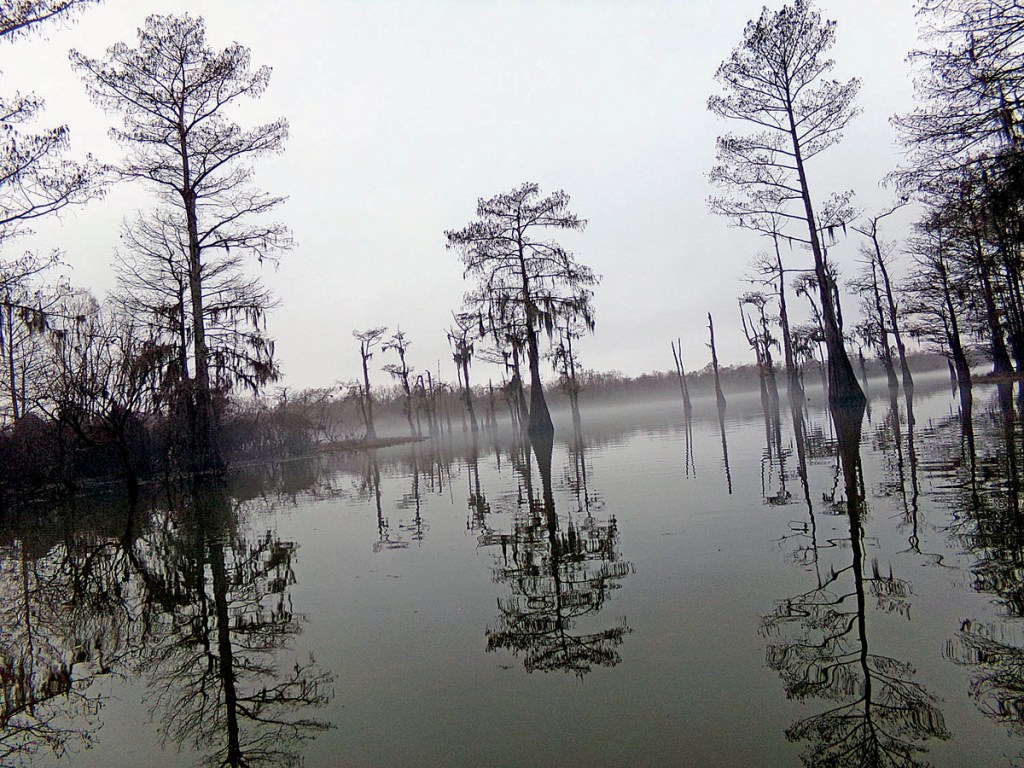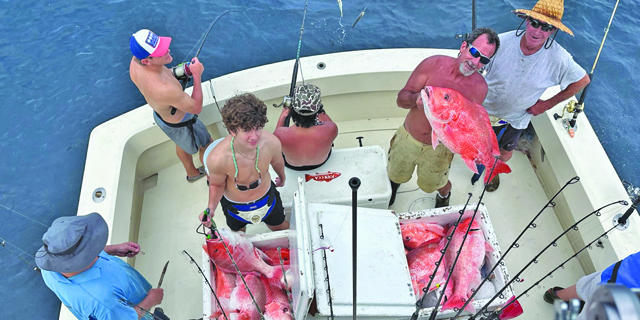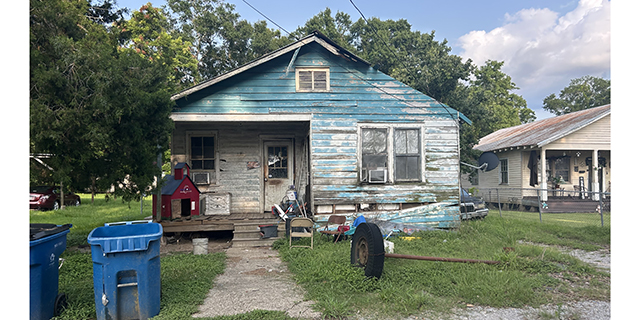Remembering beauty (and challenges) of fog on the water
Published 2:15 am Sunday, December 8, 2019

- A thin blanket of fog hovers over the water in Grevemberg, a scene framed by stately cypress trees and their silhouettes.
Foggy days and foggy nights seem to be more frequent in December and January, a weather condition that at the same time presents a picturesque scene as well as a peril for outdoorsmen.
To get to a fishin’ hole or deer stand or duck blind, fishermen and hunters often must traverse the fog going and/or coming back. I’ve done that several times over the years. One time in particular followed a return trip to Grevemberg on Jan. 10, 2018, a few days after my son, Jacob, and I enjoyed a fairly productive bassin’ trip to that jewel of the Atchafalaya Basin.
With running lights in place and shining well after sunrise, I made the trip through the fog in my 18 ½-foot Triton aluminum bass boat from Myette Point Boat Landing to Grevemberg. Aside from trying to be extra safe, the thought of getting disoriented in the fog was in the back of my mind. I remember years ago someone told me how he launched from Charenton Shell Beach Landing one foggy morning and without realizing went around in circles for quite a while in Charenton Lake.
The fog blanketed the G.A. Cut from shore to shore as the boat took me from Myette Point, past Crew Boat Chute, past Miller’s Chute, past Beehive Chute and into the cut leading to Buffalo Cove. I ran that canal carefully before getting into Buffalo Cove.
The ride through the cathedral of cypress trees shrouded in fog from Buffalo Cove to Grevemberg was wondrously beautiful, surreal. When I got to the mouth of Grevemberg, already one of the most picturesque places in the nation’s last great overflow swamp, I turned off the 115-h.p. Merc and just soaked up the panoramic scene in front of me.
Seeing a foggy scene like that in the Atchafalaya Basin makes an outdoorsman glad to be alive in the heart of Acadiana. Its beauty touches the heart and soul of the beholder, whether he or she is on a fishing trip, hunting ducks or deer, or just plain riding around.
I took my camera out of its carrying case to snap some photos from as close to the water level as possible. In my haste, I accidentally touched the video button and that six-second clip, once the camera lens pans in horizontally, is a treasure in my very limited collection.
The soft white fog cloud hung low over the water and there was barely a ripple on the surface. The reflection of the cypress trees in the water enhanced the scene.
As I looked at the fog in Grevemberg, I recalled a great foggy day on the water about 30-35 years ago with my wife, June Boutte Shoopman. We were bass fishing in November or December in the Rock Pile at Mud Cove. The heavy fog that day barely lifted to just above treetop level and we still couldn’t see the sun or the sky late in the morning.
From a distance, like when you hear the sound from afar of a train’s horn at night, we started hearing, faintly at first, the unmistakable melodious sound of geese honking. The large flock of migratory birds was traveling south to north over that scenic area of the Attakapas Wildlife Management Area.
The noise got louder and louder. The geese were on course to travel over our heads as we fished the shoreline midway down the pipeline canal. When they did, we looked up, amazed. They were flying so low under the fog bank we could see their eyes. Their honks echoed in the stillness while they kept in touch with each other, gliding under the fog with each wingbeat.
In a word, breathtaking. I will never forget those moments as goose after goose after goose passed overhead.
There was another foggy morning 30 to 35 years ago. I boated through fog to get to Coon Slough on a bass fishing trip by myself. The fog didn’t lift that day, either. If anything, it got thicker. The bass didn’t seem to mind the extra weather event and bit at will.
A young Lee LeBlanc showed up there, too, after a while. I knew the New Iberia teen from his high school pole vaulting prowess. As we fished, we’d pass and talk. At or just before midafternoon, his concern about the fog got the best of him. We left, him following my old DuraCraft aluminum bass boat safely back to Marsh Field Boat Landing. That fog was one of the heaviest I’ve seen.
As magnificent as the view was that day by myself at the mouth of Grevemberg, getting back to the boat landing in a fog that touched the water gave me pause. Boaters, like drivers in a vehicle, must exercise extreme caution if they choose to travel during those conditions. Visibility is so limited.
When I see fog while in the Atchafalaya Basin or Lake Dauterive-Fausse Pointe or on or around Vermilion Bay, I am reminded of a terrible day many years ago. That day in a pea soup fog on the G.A. Cut there was a boating fatality when two boats traveling in opposite directions collided while using the same shoreline for navigation, according to reports. That loss of life saddens me to this day.
There have been other tragic and well-documented reports of fatal boating wrecks in and around the Teche Area.
Fog has played havoc for decades with duck hunters boating along the Calumet Cut to the Wax Lake Outlet. Ditto for on and around Vermilion Bay. There are boating safety tips to follow in the fog.
1. Don’t stare out into the abyss
You can only see so far through the fog, and if you try to see farther by staring into nothingness, you’ll quickly become disoriented. Instead, pick the farthest point at which you can see the intersection between water and fog — the fog horizon. Depending on how pea soup-ish it is, this may be 200 yards off the bow, or it might only be 20 or 30 yards. In either case, if you try to peer through the fog to see farther you’ll lose all point of reference. This is why quite often, people drive in circles in the fog without even realizing the boat isn’t going more or less in a straight line. Using the fog horizon as a point of reference at least allows you to recognize when the boat is changing course.
2. Slow down
Judging safe speed isn’t easy in restricted visibility. Going so slow that you can stop before hitting something isn’t slow enough, because another boat may be closing at a speed that’s absurdly fast for the conditions. So you need to go slower than slow enough. If you feel uncomfortable, you’re probably moving too fast for the conditions.
3. Get out of traffic lanes
Let’s say you’re out on the bay, and a sudden fog drifts in. You head for the barn, and reach the marker at the mouth of the river or the beginning of the channel. But from here, you can’t see any other landmarks. It will feel comforting to stay there next to the marker, so you know exactly where you are. But (unless you do your boating in very low traffic areas) everyone else who came out from that same river mouth or channel — and then got caught in the same fog bank — is going to be heading for that very same marker. And being around a bunch of moving boats in the fog is not a good idea.
The better move is to continue navigating slowly and safely towards home. If this isn’t possible (maybe your electronics went kaput and your compass is spinning in circles), move away from the marker or channel as far as you possibly can, before holding position. And if you’re moving through a high-traffic channel, stay out of the middle. If your draft allows, parallel the channel instead of staying in it.
4. Never stop near mouth of inlet
There are many reasons why this can lead to disaster: inlets often have heavy traffic, there can be fog outside of them when it appears clear from inside the bay (or vise versa), and it’s often necessary to maintain headway when traveling an inlet in order to maintain control. If someone stops in or near the mouth of an inlet it can lead to a traffic jam, with washing-machine seas that have rocks on either side.





